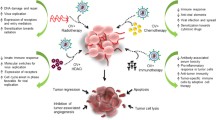Abstract
Background
Replication-competent oncolytic viruses have shown great promise as a potential cancer treatment. This study aimed to determine whether a novel vaccinia virus, GLV-1h151, with genetic modifications enhancing cancer specificity and enabling virus detection, is effective against a range of human cancers and is safe when administered in preclinical models.
Methods
GLV-1h151 was modified with deletion of thymidine kinase enhancing specificity and insertion of the green fluorescent protein (GFP) gene. The virus was tested in several human cancer cell lines for cytotoxicity including breast, lung, pancreatic, and colorectal. Virus replication was assessed via visualization of GFP expression and bioluminescence, and viral plaque assays. Finally, GLV-1h151 was administered systemically or intratumorally in mice with pancreatic cancer xenografts (PANC-1) to assess virus biodistribution, toxicity, and effect on tumor growth.
Results
GLV-1h151 effectively infected, replicated in, and killed several cancer cell types. Detection and visualization of virus replication was successful via fluorescence imaging of GFP expression, which was dose dependent. When administered intravenously or intratumorally in vivo, GLV-1h151 regressed tumor growth (P < 0.001) and displayed a good biosafety profile. GLV-1h151 infection and replication in tumors was successfully visualized via GFP and bioluminescence, with virus presence in tumors confirmed histologically.
Conclusions
GLV-1h151 is effective as an oncolytic agent against a wide range of cancers in cell culture and is effective against pancreatic human xenografts displaying a good biosafety profile and ability to be detected via optical imaging. GLV-1h151 thus adds another potential medium for the killing of cancer and detection of virus in infected tissue.






Similar content being viewed by others
References
Leaf C. Why we’re losing the war on cancer (and how to win it). Fortune. 2004;149:76–82, 84–76, 88ff.
Garattini S, Bertele V. Efficacy, safety, and cost of new anticancer drugs. BMJ. 2002;325:269–71.
Vaha-Koskela MJ, Heikkila JE, Hinkkanen AE. Oncolytic viruses in cancer therapy. Cancer Lett. 2007;254:178–216.
Brouquet A, Nordlinger B. Neoadjuvant therapy of colorectal liver metastases: lessons learned from clinical trials. J Surg Oncol. 2010;102:932–6.
Davies JM, Goldberg RM. Optimum chemotherapy regimens for neoadjuvant therapy of hepatic colorectal metastases. J Surg Oncol. 2010;102:946–54.
Adam R, Hoti E, Bredt LC. Evolution of neoadjuvant therapy for extended hepatic metastases—have we reached our (non-resectable) limit? J Surg Oncol. 2010;102:922–31.
Venook AP. Update on hepatic intra-arterial chemotherapy. Oncology (Williston Park). 1997;11:947–57.
Woo Y, Adusumilli PS, Fong Y. Advances in oncolytic viral therapy. Curr Opin Investig Drugs. 2006;7:549–59.
Garber K. China approves world’s first oncolytic virus therapy for cancer treatment. J Natl Cancer Inst. 2006;98:298–300.
Zhang Q, Yu YA, Wang E, Chen N, Danner RL, Munson PJ, et al. Eradication of solid human breast tumors in nude mice with an intravenously injected light-emitting oncolytic vaccinia virus. Cancer Res. 2007;67:10038–46.
Falkner FG, Moss B. Transient dominant selection of recombinant vaccinia viruses. J Virol. 1990;64:3108–11.
Guo ZS, Thorne SH, Bartlett DL. Oncolytic virotherapy: molecular targets in tumor-selective replication and carrier cell-mediated delivery of oncolytic viruses. Biochim Biophys Acta. 2008;1785:217–31.
Vile R, Ando D, Kirn D. The oncolytic virotherapy treatment platform for cancer: unique biological and biosafety points to consider. Cancer Gene Ther. 2002;9:1062–7.
Esposito J, Fenner F. Poxviruses. 4th ed. Philadelphia, PA: Lippincott Williams & Wilkins, 2001.
Fenner F, Henderson DA, Arita I, Jezek Z, Ladnyi ID. Smallpox and its eradication. Geneva: WHO, 1988.
Zhang Q, Yu YA, Wang E, Chen N, Danner RL, Munson PJ, et al. The highly attenuated oncolytic recombinant vaccinia virus GLV-1h68: comparative genomic features and the contribution of F14.5L inactivation. Mol Genet Genomics. 2009;282:417–35.
Yu YA, Galanis C, Woo Y, Chen N, Zhang Q, Fong Y, et al. Regression of human pancreatic tumor xenografts in mice after a single systemic injection of recombinant vaccinia virus GLV-1h68. Mol Cancer Ther. 2009;8:141–51.
Liu TC, Hwang T, Park BH, Bell J, Kirn DH. The targeted oncolytic poxvirus JX-594 demonstrates antitumoral, antivascular, and anti-HBV activities in patients with hepatocellular carcinoma. Mol Ther. 2008;16:1637–42.
Acknowledgment
We acknowledge Meryl Greenblatt for editing services. We also thank Terry Trevino, Melody Jiang, and Sen Li for technical skills and assistance with experiments. Special thanks to Dr. Ulrike Geissinger, Dr. Alexa Frentzen, Dr. Martina Zimmermann, Jennifer Reinboth, Klaas Ehring, Lisa Buckel, and Vanessa Cook for assistance with experiments.
Author information
Authors and Affiliations
Corresponding authors
Rights and permissions
About this article
Cite this article
Haddad, D., Chen, N., Zhang, Q. et al. A Novel Genetically Modified Oncolytic Vaccinia Virus in Experimental Models is Effective Against a Wide Range of Human Cancers. Ann Surg Oncol 19 (Suppl 3), 665–674 (2012). https://doi.org/10.1245/s10434-011-2198-x
Received:
Published:
Issue Date:
DOI: https://doi.org/10.1245/s10434-011-2198-x




